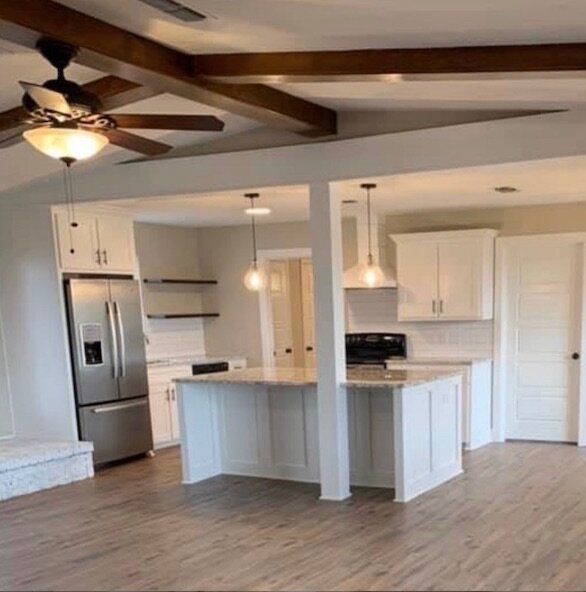So you want open concept living?…here are a few things to think about before you take the plunge with a sledgehammer to your walls.
Open Concept, Extreme Edition?! via Boston Magazine
I know it looks really appealing on HGTV to don the stylin’ safety glasses and swing a sledgehammer at the offending walls, but PLEASE before you start, make sure you REALLY want that wall gone for a good reason (other than the satisfaction of taking out your aggressions by smashing things).
AND make sure that wall is not holding up anything…like the second story…or the roof.
It is always a good idea to invest in some professional advice before DIYing anything, and especially if that something might be structural. It will save you money and headaches in the long run.
oh shoooooot…that was a load-bearing wall… image via Please Hate These Things
There are various levels of open concept living and you need to decide which one is right for you.
There is the open concept of loft living where it is one big room with maybe just the bathroom and possibly a closet sequestered behind walls - this is basically a studio apartment, though sometimes a very large one!
There is open concept where the public rooms are all one big happy space and the bedrooms and bathrooms are enclosed - this is a common style used in most apartments and townhouse condos, and many of the smaller homes people are downsizing into.
And there is open concept where the kitchen, casual dining, and seating/TV space is open, but there are other more discrete public living areas in the house.
The first two are generally a very efficient use of space and are best suited to someone living alone or at the very most a couple with highly compatible Myers-Briggs designations! They also need to have similar ideas about ideal levels of minimalism, clutter, and tolerance for chaos.
Here are the main reasons we hear for wanting to create an open plan living space:
We like to entertain
We don’t want to be trapped in the kitchen while the action is happening in the living spaces
We think it will make the space feel larger
We think it will be a more efficient use of space
We want it to feel less traditional
We want to be able to keep an eye on the kids while we are cooking
All valid.
Everyone knows that you cannot keep your guests out of the kitchen if you, the host/hostess are busy in there with preparations. I am all for well designed kitchens with adjacent spaces to corral kitchen visitors or kids playing or doing homework.
If you are someone who cleans up as they cook (or have a partner who does) so the kitchen doesn’t look like a bomb went off when you sit down to eat, then open to a dining area is perfectly fine.
We are not particularly tidy cooks in our family, and we eat in the dining room nearly every night so as not to be surrounded by the aforementioned mess while enjoying dinner.
Also, if you are ever serving Downton Abbey-esque formal dinners, a separate formal dining room (ideally with an adjacent butlers pantry to store the china and silver) is preferable. In a perfect world, I would have a butlers pantry for my dishware obsession.
A fabulous butlers pantry between the kitchen and dining room in a large, multigenerational home. Design: JRL Interiors
Sometimes, taking down a wall frees up the space to add a kitchen island increasing efficiency in the kitchen work area. We peeled back a hall wall just a few feet to take advantage of a passageway and allow us to add an island that totally transformed the layout in this builder kitchen.
Sometimes opening up walls is a mistake.
It increases the noise level - sound travels unimpeded up stairs interrupting sleep schedules and decreasing privacy.
If cooking noise and television viewing are basically in the same space and incompatible, this could be relationally problematic. I have at least one friend who is grateful her husband is hollering at the referees mostly out of earshot of the kitchen!
This cozy sitting room is the perfect place to wind down in peace at the end of the day. Design: JRL Interiors
With so many people working from home, dining rooms and living spaces are often being pressed into service as offices or zoom rooms. Having these spaces separate gives them more flexibility to turn into private space when needed.
Fueled by HGTV dramatically knocking down walls in pretty much EVERY episode, consumers, builders, and house flippers have been trained to think this is a necessity without considering the ramifications.
Nearly every builder spec home since the 80’s has some level of open concept. Usually with a kitchen and informal eating area open to a family room. Larger homes have additional enclosed spaces - offices, formal sitting rooms and formal dining rooms - smaller homes have simply a great room space for cooking/eating/sitting plus some bedrooms.
The first thing most home buyers want to do when they purchase an older home is take down some walls.
Our current more informal lifestyle can make this an appealing option but it is not for every family or appropriate for every house. Quite often rearranging the layout of the existing space can solve many problems without the need for removing whole walls or adding square footage.
Family demographics have shifted in the last 10 years. Adult children live at home longer, older parents come to stay for extended visits or move in. Caregivers looking after children or seniors may need to live in. More people are working from home at least part of the time. Far flung families may have houseguests more often. All of this means an increased need for privacy and noise control in at least some areas of the home.
The rear view of a gracious Gentleman’s Farm, home to three generations of a family. Here, the local equestrian hunt club traveling through their property.
Gracious older homes with well laid out enfilades of rooms, gorgeous millwork, and lovely proportions may be completely compromised by insisting on taking out walls. Perhaps choose a different style of house if you want modern and open concept…
In summary, open concept can be great or terrible - it all depends on your home and situation! Just don’t break out the sledgehammer without thinking carefully about what problems you are really trying to solve and all the possible solutions!








